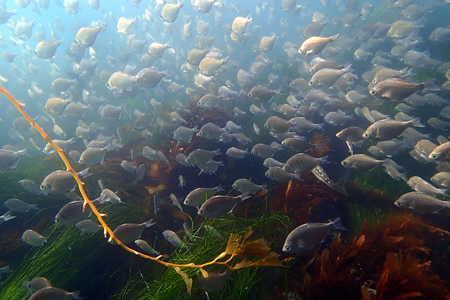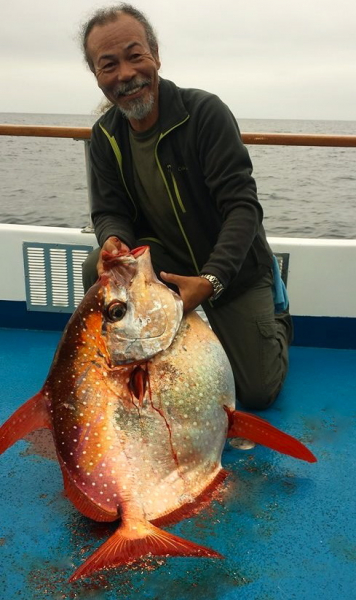By Rita Robinson | LB Indy

Divers, snorkelers and recreational fishing enthusiasts alike are reporting increasing numbers of fish off the local coastline.
This summer’s catch of sport fish – yellowtail, yellowfin and bluefin tunas as well as dorado – has not been seen since 1997, said Donna Kalez, general manager of Dana Wharf Sportfishing and Whale Watching Tours in Dana Point.
On Sunday, July 27, with 10 boats in the water and 334 anglers on board, 26 yellowfin tuna, 26 bluefin tuna, 11 yellowtail and three dorado were hooked, she said.
Unusually warm water, which typically accompanies an El Niño weather event, is luring all the fish, according to Carrie Wilson, associate marine biologist with the California Department of Fish and Wildlife. “I feel very confident about this; it’s the warm water that’s coming in,” she said. “Those species are pelagic species; they’re all coming from Mexico.” Pelagic fish, such as tuna and dorado, follow warm water currents worldwide. El Niño conditions bring warm-water fish to the more northern and normally cooler waters of the Southern California coastline.
Some of the fish now in local waters are even considered a rare catch, said Jim Mulberry, a National Oceanic and Atmospheric Administration spokesman. One of those rare fish, an opah, was caught about 50 miles south of Dana Point and 22 miles east of San Clemente Island.

Opah are mostly solitary fish that live in tropical and temperate waters. Catching one off the local coastline confirms the El Niño conditions, according to Pete Thomas, an NOAA blog writer. Sportfishing boats go out at least three miles to catch prize fish, such as tuna, on overnight tours with the majority being caught about 18 miles out, said Kalez.
“It’s a frenzy,” said Kalez. “It’s these tuna that get people in a frenzy.” The tuna have not been sighted in local waters in these numbers for 17 years, said Kalez. Anglers typically travel to waters off of Baja California to catch tuna.
A blanket no-fishing rule imposed in 2012 by state wildlife regulators restricts fishing of all kinds along most of Laguna’s seven miles of coastline. The Marine Life Protected Area covers three miles out to sea and its comprehensive no-take designation prohibits sportsfishing, spearfishing and lobster-trapping.
Christine Pattison, a senior environmental scientist at the Department of Fish and Wildlife, said it’s way too soon to know if the MLPA in Laguna Beach is attracting more fish. “Obviously, we have seasonal movement of fish,” she said, adding that the department won’t know what effect the restrictions are having for at least four more years when an official survey will be conducted.
It may not be certain if the protection of marine species living in kelp forests and rocky reefs near the local shoreline accounts for this summer’s abundance of fish, but it’s obviously not hurting sportfishing either, conceded Kalez.
The abundance of kelp bass varieties spotted close to shore is probably due to the protected area in Laguna, she agreed. Wildlife regulators also set a new size limit on catching bass, to 14 inches from 12, which has contributed to greater numbers in the ocean over the last 18 months, she surmised. Last Sunday, Dana Wharf Sportfishing boats recorded catching and releasing 405 calico bass and 20 sand bass. “Those fish are not hurting,” Kalez said.
Though scientists have yet to link the no-fishing rule to the abundance of fish in kelp forests off Laguna, snorkelers and scuba divers are claiming that subtidal fish are back in droves.

“It’s an explosion,” said Sandy Dildine, a member of Laguna Bluebelt, a local ocean environmentalist coalition that supports marine protections. She’s also snorkeled in Laguna for the last 25 years and now snorkels at least four times a week.
Dildine is spotting more sheepshead, a blunt-snouted fish with canine teeth that feeds on sea urchins. “The kelp is a nursery and habitat for a lot of baby reef fish and now the reef fish are growing into adults because they’re being protected,” she said. “There are so many adult opaleye out there and calico and kelp bass, kelp perch and zebra fish and giant kelp fish. And there’s baby blacksmith in swarms near the kelp.” The actual kelp fish look like floating kelp fronds and young blacksmith fish have blue heads and orange tails.
Compared to conditions in nearby beach cities, Laguna’s rocky reefs offer more viewing variety per dive. “I don’t see nearly as much diving in Corona del Mar as I see diving in Laguna Beach,” said Nick Cord, who works at Laguna Sea Sports. Diving in local waters for the past two years, Cord said there was more sea life to see here even before the warmer water appeared and he attributes it to the MLPA restrictions.
Current conditions are creating “the perfect storm” in a good way, said Kalez, for businesses like hers. “The water’s super-nutrient rich and we have (blue) whales out there like crazy,” she said. “The warm water and the currents are bringing the fish up here. All those things together are making it an amazing season. We are so busy down here.”
All walks of life are suddenly developing sea legs, eager to test their luck. “It’s not your super-professional fisherman,” said Kalez. “We have senior citizens. We had a women’s group. We even had veterans out there in wheelchairs catching yellowtail.”





[…] was disappointing to read in the article “Fish Flourish in Warm Coastal Waters” (Aug. 3) the excitement of Donna Kalez of Dana Wharf Sportfishing over the pelagic visitors from […]
[…] Flourish in Warm Coastal Waters http://www.lagunabeachindy.com/fish-flourish-warm-coastal-waters/ Geophysics have punctured one of the main arguments of global warming activists, that the large […]
[…] marlin are finding their way onto hooks in Southern California waters, according to Mantua and fishing reports from Dana Point Harbor. “You don’t usually see yellowtail swimming in 10 feet of water,” […]